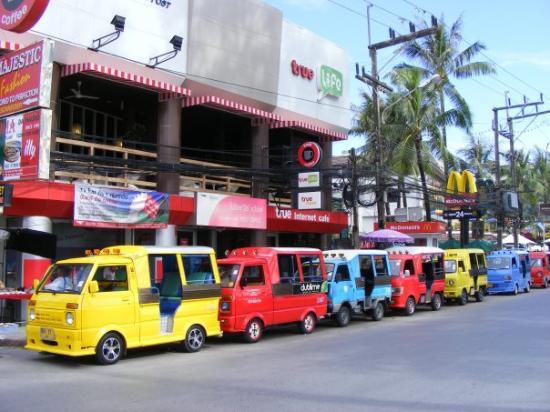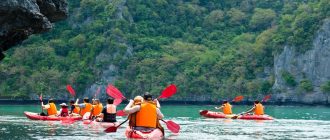Phuket has been an international holiday destination for decades, but recent years have brought major changes to the island, many of them for the worse. This post recounts some common complaints about Phuket for tourists and expats alike.
Expensive
Thailand is not as cheap as it used to be. Of course the same can be said for anywhere, but in 2008 when the value of the USD, British Pound and Euro all decreased by approximately a third in relation to the Thai baht, long term expats who had been living quite comfortably off their foreign income suddenly found their monthly expenses rising by up to 35%. Regular tourists who visited at least once or twice a year found it less affordable.
Phuket, however is more expensive than the rest of Thailand. Hotels, house rentals, restaurants and groceries are all pricier than anywhere else in Thailand. The common figure expressed is 30-40% more expensive.
A good illustration of this is to survey the menus of popular restaurant chains in Thailand. Buying a drink at a Fuji restaurant in Bangkok or Pattaya might cost you 50 Baht whereas the same exact drink on the very same menu will cost you 80 baht in Phuket. Why is phuket so expensive?
Public Transport
For a supposedly world class tourist destination, the public transport system is atrocious. Technically it exists, but practically it might as well not, at least not for tourists and the vast majority of expats.
Phuket’s public transport system consists of songtaews, but the way the system works is so idiotic that no visitor could ever use it. The service runs from each beach into town. The problem with that is if you want to go from one beach to another you would have to go via Phuket town, so a 10 minute trip directly between the beaches would end up taking you 2-3 hours because you have to go via town. It would be so easy and inexpensive to fix this and create better routes, but that would piss off the tuk tuk drivers.
Tuk Tuks
Phuket’s tuk tuk drivers have a reputation for belligerence and greed operating a system set up to rip off tourists. If it’s your first time in Phuket you might think tuk tuks look cool and quaint. Once you realise you’re basically paying London taxi prices to sit in the back of a little pick up truck with no air con, seat belts or suspension that soon wears off.
Violent and confrontational tuk tuk drivers are a problem, there is almost always a story in the news about Phuket tuk tuk violence. Still, if you agree to pay a price and don’t do anything to insult the driver the chances of him and his friends assaulting you are usually very small.
Driving
Driving a car in Phuket can be quite an irritating experience. The roads, while paved, are basically one step up from village roads and aren’t very wide. They were built at a time when there were far fewer people and it worked fine. Nowadays there are just lots more cars and lots more mopeds, and if you’re driving a car it’s the mopeds you have to watch out for.
Moped drivers have a totally different mindset to car drivers. They just want to get from A to B and don’t concern themselves too much with traffic conventions. It’s quite common for them to :
- Drive slowly in the middle of the lane making overtaking impossible.
- Overtake then cut in front of you and reduce speed suddenly. This happens when turning at lights or traffic circles.
- Two mopeds can overtake you simultaneously on the left and right.
- Ride right behind you in the mirror blind spot then pop out of nowhere.
You basically need to have 360 degree awareness because if you hit one of them it will be your fault.
Traffic
The road networks just can’t support the number of cars anymore. Trying to get into town from one of the beach areas can take an hour or more sometimes. This epitomizes the crux of the Phuket problem. It’s lost the small town charm but kept the infrastructure.
Crime
Phuket seems to suffer from a high rate of crime. There are stories every week of people getting murdered or beaten up in Phuket. While this happens in every major city on earth, Phuket isn’t a major city, it’s supposed to be a nice sunny tropical island. Life here is still perfectly safe for most people most of the time. It’s just unnerving to know that these undesirable elements exist in such close proximity to you.
Electrcity Wires
Pretty much all electric wires on the Island run above ground and maybe it’s me just being a white western wimp but it seems pretty dangerous. Given the frequent storms they could snap and fall into a puddle and electrocute someone.
Everything goes to Bangkok
Whenever something breaks and you take it to get fixed you almost always get told that they need to order the parts from Bangkok. This could be a laptop screen or spare parts for an air con unit. It’s just annoying that you have to wait for that and the people running the repair shop don’t think it’s a good idea to stock spare parts themselves.
Narrow Pavements
This is especially felt in most tourist areas. The pavements are only wide enough for 2 people at the most. Add to that that they are lined with massage girls and shopkeepers trying to sell you stuff right there on the pavement and it makes for an unpleasant walking experience.
Bad Massages
These shops are everywhere. What tourists don’t know is that the majority of girls working there haven’t got a clue how to do a proper massage. This is annoying as it would only take a couple of weeks training to get qualified for really cheap as there are several massage schools in Thailand. Finding a place to get a good massage in Phuket is not impossible, but it’s also not that easy!
Expensive Restaurants & Bad Service
The prices charged at many restaurants in the tourist areas are on par with anywhere else in the world; not so the service and often the food. This is especially if you are ordering European food.
The Thai staff hired to cook have literally never heard of the dish you ordered before, and even if he was taught how to cook it, he’s not going to be able to do it the way a European would. There are good restaurants, but the variance in standards is great and it’s pot luck finding a good one.
Then there’s the service. The restaurant has been decorated to look really classy, but the service staff have no idea how to serve customers in a way that is commensurate with what one would expect from a decent restaurant. They more often than not are clueless, lazy, are very quick to be rude if you ask them to correct something. It just detracts from the dining experience.
The Locals
People from the south of Thailand have something of a reputation for being a bit less friendly, and it’s not just a Muslim thing. Depending on the context within which you meet them they can be really friendly or not. Generally if you are in a tourist area, you’re going to be in contact with Thais who are trying to make a living and deal with tourists everyday. They can get jaded like anywhere else.
Outside of the typical tourist context, southern Thais are very friendly, but making sustainable and meaningful friendships can be quite hard. A Thai who lived in the States or Europe for 10 years would be more likely to have integrated and made real friendships with locals there, than a westerner would with Thais here.
Development
There’s too much of it and the wrong kind. Development is limited to private developers building hotels, villas and shophouses which then become bars, restaurants and massage places.
Pretty soon a once quiet village has cement trucks going up and down it all day and you have 50 new restaurants, pharmacies and massage shops in the area. But the roads didn’t get wider to cope with the increased inhabitants and nobody thought about putting any parking spaces anywhere.
Lack of Facilities
Conversely there is little by way of government funded development for the public. There’s a lot of talk about plans and large investments but to date they still didn’t figure out to change the songtaew routes!
There are no nice nature trails that are open to the public for free. There are places where you can ride an elephant or go ATV riding if you are ready to spend $100 for an hour, but almost no public parks, recreation grounds, cultural centers, public art galleries or museums.





